Developers all around the world are understandably intrigued by the advent of Web3 apps, dApps, and the prospect of a decentralized web. Nevertheless, the growing Web3 ecosystem is somewhat fragmented, and developers can choose to build with a long list of blockchain. We’ve previously written about Ethereum, and how to create Ethereum dApps using Moralis. Although the Ethereum network plays home to a vast selection of dApps, Ethereum infamously struggles with high gas fees. As this is the case, we ought to look at some alternatives, and a great option is BSC (Binance Smart Chain). BSC is, just like Ethereum, one of the big blockchains for building dApps (decentralized applications). For this reason, we will take this article to look closer at how to create BSC dApps and look at some applications that already exist on the market.
If you are a returning reader here at the Moralis blog, you will know that the best way to build BSC dApps and connect to BSC nodes is through Moralis. Moralis is the number one middleware for dApp development, and as a user, you’ll be able to save valuable resources and time. Moralis provides its users with a fully managed, infinitely scalable backend infrastructure. This means that you, as a developer, can focus your time and efforts on developing the frontend and core functionality of your project.
Moreover, Moralis also offers many tools for developers, such as native support for MetaMask, IPFS, the Moralis NFT API, and much more. However, we’ll also take a closer look at Moralis in a separate section of the article.
So, if you are looking to become a dApp developer today, do not hesitate to sign up with Moralis! It is entirely free, and you get immediate access to all the tools of the platform.
What is BSC (Binance Smart Chain)?
Before delving into how we can create BSC dApps, we should first understand what BSC is and why this chain is suitable for development purposes. As such, we’ll take this section to explain BSC.
BSC is an abbreviation for Binance Smart Chain, and is a sister product to the original Binance Chain. The original Binance blockchain was created in 2019, with the intent of facilitating fast and decentralized transactions. However, as this chain was optimized to facilitate transactions, it lacked flexibility. As a result, the Binance Chain would have to compromize speed-wise if it added more complex transactions. So to solve these ”flaws”, Binance’s solution was to create Binance Smart Chain, or BSC.
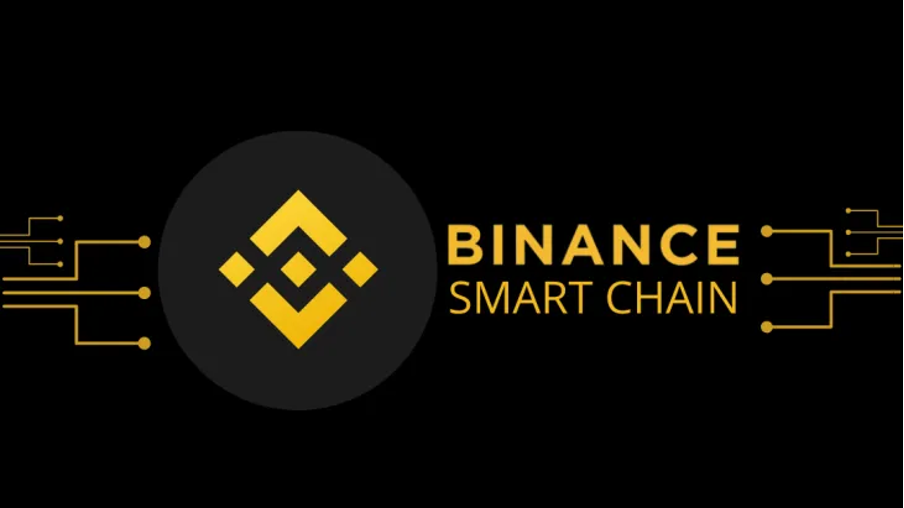
The ultimate reason for creating BSC was to pave the way for introducing smart contracts to the Binance ecosystem. The original chain remains to facilitate fast and reliable transactions; meanwhile, BSC takes care of Web3 development. As a result, the two chains now run parallel with one another, but play different functions.
To ensure that the ecosystem is functioning as it should, the Binance system utilizes a ”dual-chain” architecture. This means that it is possible to transfer funds between the Binance Chain and BSC seamlessly. This enables a great synergy between the chains and makes sure that it is possible to leave the high throughput to the Binance Chain and dApp development to BSC.
Furthermore, this only touches the surface of what BSC is, and there is a lot more to the Binance ecosystem. So, if you are interested in learning more, we recommend checking out their official website. Here you will find more technical information regarding the blockchains.
Moralis Explained
As we mentioned in the initial paragraphs, Moralis is the best middleware for Web3 development. However, what makes Moralis the best platform for creating dApps?
The main issue with developing dApps is backend development. From a traditional perspective, backend development has been a time-consuming and resource-intensive endeavor. Not many people are aware of how to set up a fully functioning backend infrastructure, which is one of the reasons that dApp development faces issues. However, one can avoid this by using Moralis.

Moralis provides its users with a fully managed backend infrastructure, which means that developers don’t need to worry about this problem. As a result, developers can direct more of their attention to developing smart contracts and the frontend of their dApps.
Furthermore, the platform users also get access to several other essential development tools. Some examples are Moralis’ Speedy Nodes, native support for MetaMask, IPFS, cross-chain compatibility, the Moralis NFT API, and much more.
As Moralis provides both an infinitely scalable backend infrastructure along with valuable tools for dApp development, it makes Moralis the ultimate development platform for Web3. This means that we can create serverless dApps at a fraction of the time to significantly shorten the time to market.
So, with Moralis, you’ll get full access to all the tools needed for developing and deploying your first dApps. As this is the case, we highly recommend signing up with Moralis today. Getting started only takes a few moments, and you can begin your dApp development journey straight away!
What are BSC dApps?
Before diving deeper into how to create BSC dApps, we must first understand what they are. Like most dApps, BSC applications consist of three main parts: a frontend, smart contracts, and a backend. Moralis takes care of the backend of the dApps, but how about the rest?
Frontend development, in the context of dApps, does not differ much from regular applications. Knowledge of JavaScript is essential, as well as HTML and CSS. However, one way in which it differs is that a basic understanding of Web3.js is required. The Binance Chain and BSC differ because BSC is compatible with EVM (Ethereum Virtual Machine). This is great for BSC, since it allows us to develop BSC dApps with the same tools as for Ethereum dApps.
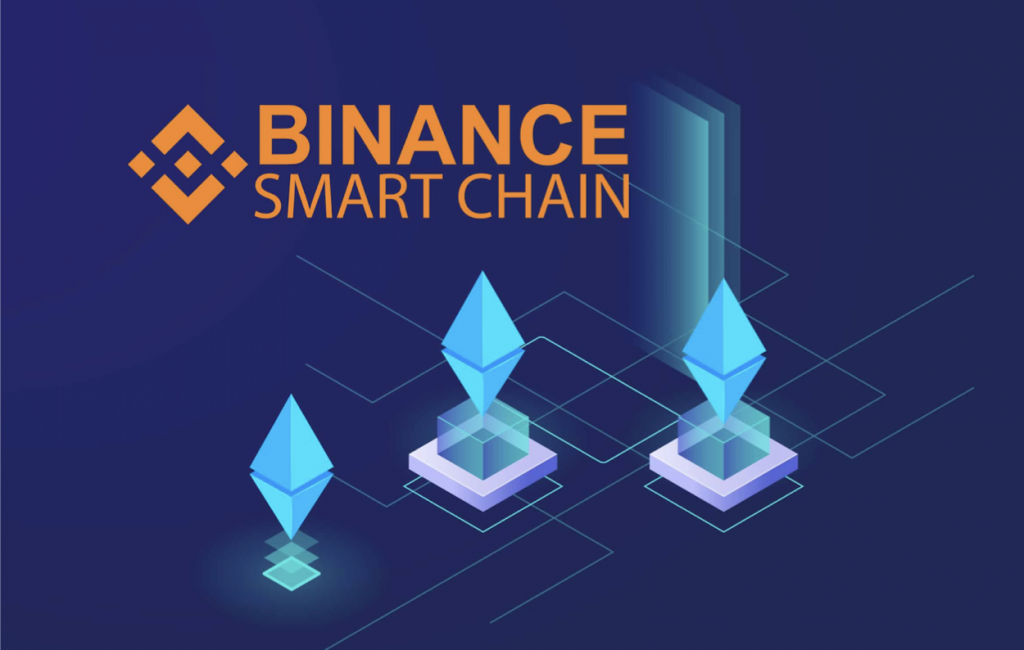
This means that we can utilize tools such as MetaMask, Hardhat, Truffle Suite, and much more. Furthermore, this also means that the contracts for our applications can be developed using the Solidity programming language.
Smart contracts are basically programs running on a blockchain that users of the chain can interact with. A metaphor for what a smart contract is that is widely used is a vending machine. We input an asset into the contract, and then something is returned to us as a result. This further means that they act similarly to traditional contracts but have the power to enforce rules through the code.
These contracts for the BSC chain can be written in Solidity, which is one of the most widely used programming languages for smart contracts. Solidity is object-oriented and has a lot of influences from C++. It also supports a lot of useful features such as inheritance and libraries. However, you can read more about the language in our comprehensive summary of Solidity.
How to Create BSC dApps quickly with Moralis
Creating dApps with Moralis is a blast, since the development process can be shortened tremendously. The process is quick and easy, and to get going with your first project, only three main steps are needed. The first thing that we need to do is to set up a server, then install the Moralis SDK (Software Development kit), and finally, initialize Moralis.
This is all that we need to do to get going with our first project, and now that we have a better understanding of BSC and Moralis, we can dive deeper into how to create BSC dApps.
Setup Process
Adding an Instance — The first thing we need to do is add a new instance to Moralis. The first step in the process is to hit the ”Create a new App” button at the top right of your browser. This will provide us with a dropdown menu with three different alternatives. The choice here might differ depending on if we want to run our application on a test, main, or dev chain.
Once either alternative is pressed, you will be provided with a new window. You need to input a name, select a region, and select what network you want to connect to. Moralis supports cross-chain transactions, which means that you can choose more than one alternative here. However, as we are looking to create a BSC dApp, we should include this as one of the options.
Once we are all done with our selections, we can simply hit the ”Add Instance” button at the bottom right to set up a server for our first Moralis project.
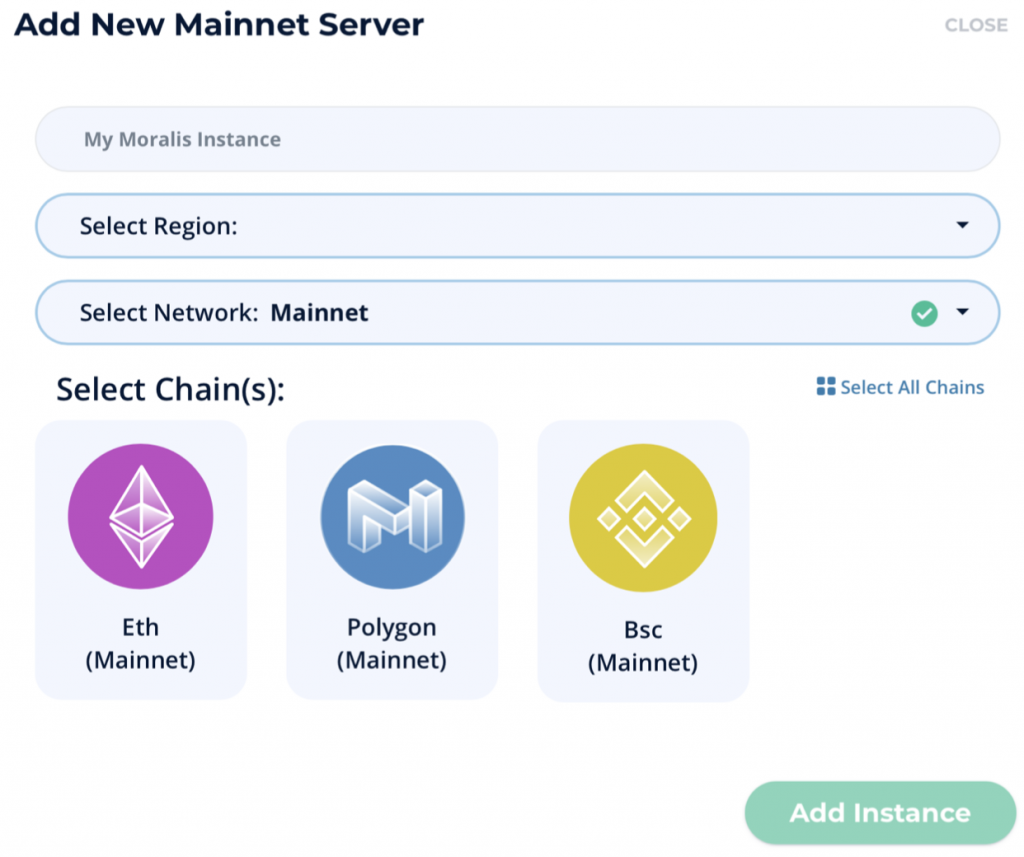
Install Moralis SDK — The next step is to install the Moralis SDK, and this can be done in several ways. However, the fastest way is through CDN, and you can find the npm-CDN here.

Initialize Moralis — The last thing we need to do is to initialize Moralis. To do so, we need some information regarding the server we just created. To find this information, we need to click the ”View Details” button on the server. When clicked, we will be presented with a bunch of information, and what we are interested in here is the App ID and the Server URL. Once we have this info, we can use it in the following way:

Setting Up Local Dev Chain for Creating BSC dApps
Another optional alternative is to set up your own local blockchain. Specifically, those who are new to Web3 development can stick to simply using a testnet or mainnet through Moralis. However, in some niche use cases, it can be necessary to set up a local dev chain.
There are two main reasons for setting up a local blockchain; the first is to save time, and the other is to save resources. We can save time because we do not need to upload dApps and smart contracts before they are completely functional. When deploying a contract to a chain, we must pay gas fees and wait for the transactions to go through. As a result, we waste money and time if the contracts and dApps are not fully operational.
However, this can be avoided by using a local dev chain. To set up a local dev chain, we recommend using either Ganache or Hardhat. These applications allow you to set up your own blockchain to test your code in a safe and deterministic environment.
Furthermore, when using either Ganache or Hardhat, it is possible to easily connect your Moralis projects to the local blockchain since Moralis supports both platforms. However, if you are interested in learning more about setting up your local blockchain, we recommend the following two videos from the Moralis YouTube channel:
Furthermore, setting up a server and your own local blockchain are just some of the steps to creating your BSC dApp. If you want to learn more about the functionality of Moralis and to move on in the development process, we recommend checking out this quickstart guide from the Moralis documentation.
How to Create BSC dApps – Inspiration
Even though Binance Smart Chain is comparatively new, a sizable ecosystem of BSC dApps is already emerging. Furthermore, the Binance Smart Chain ecosystem is home to some of the most well-used dApps on the market, second only to Ethereum. However, to help you get some inspiration, we will go through three interesting dApps on BSC.
PancakeSwap
PancakeSwap is probably one of the most well-known protocols on BSC, and it is an automated market maker (AMM). This means that PancakeSwap allows users to trade assets that run on the blockchain. Furthermore, PancakeSwap also enables investors to stake and yield farm assets, allowing them to earn high APYs (Annual Percentage Yields). PancakeSwap aims to become the number one liquidity provider on Binance Smart Chain.

To become part of PancakeSwap, you will need a BSC-compatible wallet. Two alternatives here are MetaMask and Trust Wallet. If you have a wallet, you will be able to swap tokens, provide liquidity or stake tokens to earn some yield in return.
Furthermore, there is also a PancakeSwap lottery where participants can win a part of the prize pool. Everyone can buy a ticket with CAKE, and each ticket consists of six numbers. The more numbers that are correct, the bigger the price. A ticket usually costs around $5, but the price differs depending on the exact CAKE price set at the beginning of the round.
Venus
Venus is a DeFi platform for lending and borrowing currencies. Therefore, users can borrow money against collateral, and the convenience here is that there is no need to pass a credit check. This also means that people can deposit assets into a lending pool and receive an APY on their digital currencies.
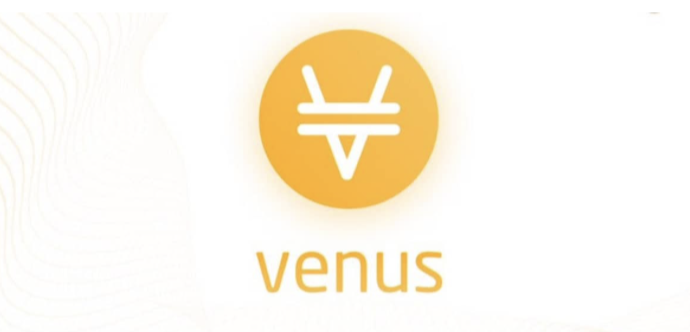
Venus has two different BEP-20 tokens: XVS and VAI. XVS is the token that the community uses for governance and voting; meanwhile, VAI is a stablecoin pegged to the USD. It is possible to earn or mint VAI after releasing collateral and receive XVS as an incentive to contribute to the liquidity pools.
To start earning assets and contributing to the liquidity pool, you will need a BSC wallet to connect to the platform. Then you are good to go and can choose whatever assets you would like to deposit and decide the amount you want to lend.
Autofarm
The last dApp that we are going to look somewhat closer at is Autofarm. This is a DeFi platform that provides both a yield aggregator and a decentralized exchange (DEX). Autofarm was first introduced to the market late in 2020 and has seen a period of rapid growth ever since.
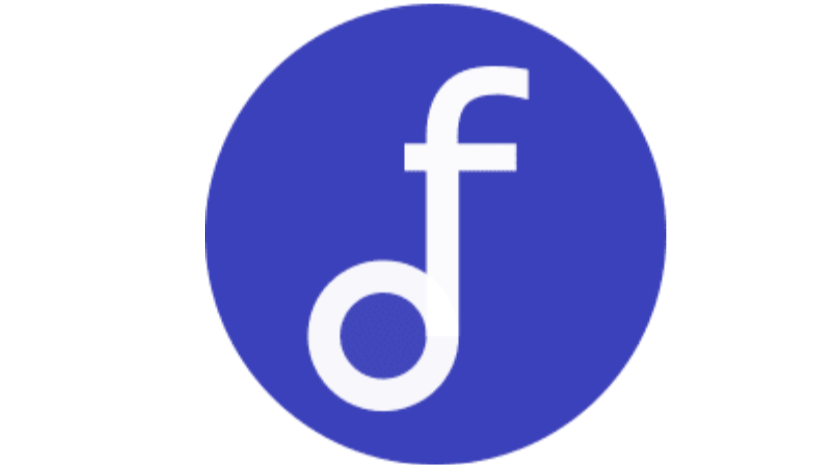
The dApp consists of two parts; the Autofarm vaults, and AutoSwaps. The vaults allow users to lock up their assets into a smart contract and earn interest on it. What makes these vaults unique is that they automatically optimize to provide the users with a high yield.
AutoSwaps, on the other hand, is a DEX aggregator that can fetch the best price from several DEXes on BSC. By doing so, it will provide the users with the best possible prices and minimize slippage.
However, these are just three of the largest platforms on BSC, and there are many, many more. Hopefully, these have provided you with some inspiration for when you start to build your first dApp. Maybe you will be the one to create the subsequent great success of BSC!
So, if you are interested in becoming a dApp developer, sign up with Moralis as this is the easiest and quickest way for you to build your first BSC dApp.
How to Create BSC dApps – Summary
There are several different blockchains for dApps development, but the most popular alternative is Ethereum. However, this chain is experiencing problems with congested networks that makes development on this chain a little more complicated. Nonetheless, Ethereum is still widely used, but it is worth discovering some other alternative chains due to these problems, one of which is BSC (Binance Smart Chain).
BSC is home to some great dApps such as PancakeSwap, Venus, and Autofarm. However, the ecosystem is vast, and these are just three alternative applications to demonstrate the chain’s capabilities. Furthermore, dApp development has traditionally had some issues where the most significant problem has been backend development. However, this does not longer need to be an issue with Moralis. As a Moralis user, you will be provided with an infinitely scalable backend infrastructure, meaning that you can focus elsewhere on, for example, smart contract development.
As this is the case, the best and quickest way to create BSC dApps is with Moralis. To get your first dApp going, all that is needed is three initial steps:
- Set up a server
- Install the Moralis SDK
- Initialize Moralis
Furthermore, Moralis provides some great development tools such as the Moralis’ Speedy Nodes that we mentioned earlier. They feature both full nodes and archive nodes along with support for WebSockets.
So, if you are interested in becoming a dApp developer, signing up with Moralis is the right way to go. Creating an account is entirely free, and you’ll receive access to all the platform’s tools immediately.
